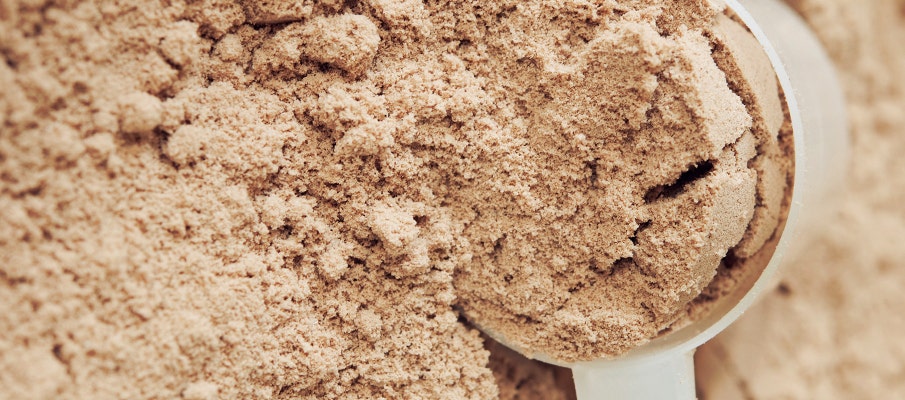Whey Protein 101
- 8/28/23


Whey protein powder is one of the most popular supplements today, whether you’re looking to support your fitness regimen or simply add a convenient protein source to your daily routine.
But with all the protein powders out there, you may be curious, what is whey, exactly? Where does it come from and what benefits can it offer? Let’s take a deep dive into whey protein.
What is Whey?
Where does whey protein come from? Most simply put, whey is the byproduct of the cheesemaking process. It’s one of the two main proteins in dairy milk, along with casein. These two proteins make up 20% and 80% of the proteins in milk, respectively.
When cheese is made, the fat-rich parts of the milk coagulate into curds. When this happens, there is a cloudy, yellow-hued liquid released from the curds. And when fresh yogurt is strained, that same liquid is left over. You might notice this as the liquid sitting on top of the yogurt when you open a new container. As you probably guessed, this is the fresh whey protein.
How Whey is Used
The leftover protein-rich liquid from making cheese and yogurt may not sound very appealing on its own, and you’re probably wondering how many ways there are to repurpose it. As it turns out, whey has many commercial food uses, many of which you may have consumed before.
Whey has been one of the most popular protein powders on the market for years. Whey protein is also used to boost the protein content of many packaged foods, such as protein bars and pancake mixes. When you purchase whey protein powder, you might use it in protein shakes, add it to fruit smoothies, mix it into muffin batter, or even stir it into your oatmeal or yogurt.
Types of Whey Protein
Whey protein can be found in most grocery stores, sports supplement stores, and on many online commerce stores. Commercially sold whey protein comes in a few different forms, depending on how you’re planning to use it.
These include:
- Whey hydrolysate: Also called hydrolyzed whey protein, this whey has been pre-digested and broken down so that you can better tolerate it. Whey hydrolysate also has a faster absorption rate than other forms.
- Whey isolate: This form contains less lactose and fat but is also missing many key nutrients found in other forms of whey protein. This option is made of 90% protein or more.
- Whey concentrate: This popular option contains around 70-80% protein. It contains some fat and lactose, and many people prefer the creamier flavor it can offer compared to the other forms.
Whey Protein Flavor
If you’ve never had whey protein before, you may be curious about what it tastes like before you buy some. Unflavored fresh whey is often described as creamy and mildly sour, similar to plain unsweetened yogurt.
Of course, commercial whey protein products also come in a variety of flavors. Some of the most popular are vanilla, chocolate, strawberry, and peanut butter. Depending on what you plan to use it for, you might pick up one of these flavors that suits your palate.
Is Whey Protein Good For You?
Many people prefer whey protein over other types, but is it actually good for you? There are several potential benefits of whey protein. Let’s look at some of them in further detail.
1. May help support muscle building
Whether you’re looking to boost your muscle growth or counteract the natural decline in muscle mass that happens as we age, whey protein may be a helpful supplement for your routine, particularly if you don’t get enough protein in your diet overall. Whey protein is rich in an amino acid called leucine, which is known to help promote muscle growth. Pair whey protein with protein sources in your diet and a resistance training regimen.
2. May support antioxidant activity
While whey protein itself is not high in antioxidants, some evidence suggests that getting enough of certain amino acids it contains—like cysteine—can help produce a compound called glutathione. Glutathione is a powerful antioxidant in the body.
3. May help promote satiety
Protein is known to help keep us feeling fuller for longer after a meal or snack. While protein is found in many foods, such as legumes, nuts, seeds, poultry, eggs, and dairy products, whey protein appears to have a more satiating effect than many other protein powders. When we’re more satisfied after eating, we’re less likely to overeat overall.
Potential Downsides
Whey is generally a safe protein powder option for most people. However, people who have a milk allergy should avoid it. Because it is a byproduct of dairy, those who are highly sensitive to lactose may also experience some symptoms from consuming whey, though it depends on the individual.
Choosing a Whey Protein for You
When choosing a whey protein powder for your lifestyle, there are a few things to consider.
- Use: How you’re going to use whey protein helps determine the best form and flavor for you to purchase. For instance, if you’d like to use it to enhance your fruit smoothies, you might opt for a vanilla or strawberry whey protein hydrolysate.
- Third-party testing: Brands that invest in independent testing for the purity, safety, and quality of their product go above and beyond for consumers. Look for seals from places like NSF International, USP, or Informed Choice.
- Protein content: Protein powders can vary in how much protein they provide per serving. If this is important to you, be sure to check the nutrition facts label to determine whether a product meets your preferences.
Garden of Life offers a line of grass-fed whey protein powder products in several flavors, including chocolate, vanilla, peanut butter chocolate, strawberry, and lightly sweetened plain. Most products carry a USDA Organic certification, while some are also Non-GMO Project Verified.
Several of the sport protein powders have also been third-party verified for quality, purity, and safe use for professional athletes, bearing the Informed-Choice and/or NSF Certified for Sport label. Garden of Life whey protein powders range from 21 to 24 grams of protein per serving.
Whey protein is a versatile and well-researched product that many people find beneficial as part of their everyday health regimens. If you’re looking for a way to add extra protein that comes in multiple flavors, forms, and uses, whey protein may be a good option for consideration.
References:
-
Power O, Hallihan A, Jakeman P. Human insulinotropic response to oral ingestion of native and hydrolysed whey protein. Amino Acids. 2009 Jul;37(2):333-9. doi: 10.1007/s00726-008-0156-0. Epub 2008 Aug 5. PMID: 18679613.
-
Lynch HM, Buman MP, Dickinson JM, Ransdell LB, Johnston CS, Wharton CM. No Significant Differences in Muscle Growth and Strength Development When Consuming Soy and Whey Protein Supplements Matched for Leucine Following a 12 Week Resistance Training Program in Men and Women: A Randomized Trial. Int J Environ Res Public Health. 2020 May 29;17(11):3871. doi: 10.3390/ijerph17113871. PMID: 32486007; PMCID: PMC7312446.
-
Averill-Bates DA. The antioxidant glutathione. Vitam Horm. 2023;121:109-141. doi: 10.1016/bs.vh.2022.09.002. Epub 2023 Jan 13. PMID: 36707132.
-
Pal S, Radavelli-Bagatini S, Hagger M, Ellis V. Comparative effects of whey and casein proteins on satiety in overweight and obese individuals: a randomized controlled trial. Eur J Clin Nutr. 2014 Sep;68(9):980-6. doi: 10.1038/ejcn.2014.84. Epub 2014 May 7. PMID: 24801369.





